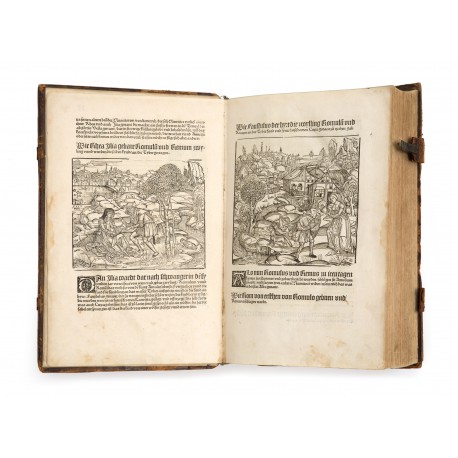Romische historien Titi liuii mit etlichen newen Translation so kurtzuerschienen jaren im hohen thum Styfft zu Mentz jm latein erfunden und vorhyn nit mer gesehen sein [a free paraphrase by Bernard Schöfferlin, continued by Ivo Wittich, with additions by Nikolaus Fabri Carbach]
- Subjects
- Book illustration - Artists, German - Faber von Creuznach (Conrad), c. 1500-c. 1553
- History, Ancient - Early works to 1800
- Authors/Creators
- Livius, Titus, 59/64 BC-17 AD
- Artists/Illustrators
- Faber von Creuznach, Conrad, c. 1500-c. 1553
- Printers/Publishers
- Schöffer, Johann, active 1503-1531
- Owners
- Erlach, Abraham von, 1716-1782
- Other names
- Carbach, Nikolaus Fabri von, c. 1485-c. 1534
- Schöfferlin, Bernhard, 1436-1501
- Wittich, Ivo, died 1507
Livius, Titus
Patavium 59/64 bc – 17 ad Patavium
Romische historien Titi liuii mit etlichen newen Translation so kurtzuerschienen jaren im hohen thum Styfft zu Mentz jm latein erfunden und vorhyn nit mer gesehen sein [a free paraphrase by Bernard Schöfferlin, continued by Ivo Wittich, with additions by Nikolaus Fabri Carbach].
Mainz, Johann Schöffer, 1523
folio (320 × 205 mm), (453) ff. signed π6 a4 b–o6 p4 A8 B–R6 (blank R6) Aa8 Bb–Ee6 Ff82π16 Gg4 Hh–Zz6 Aaa–Nnn6 Ooo4 Ppp6 16 28 (lacking final blank) and irregularly foliated as usual (2) 1–90 (1) 90–191 (2) 193–197 199–232 232–236 236–247 233–420 (13). Four woodcut compartments (title and sub-titles), another woodcut compartment enclosing first page of dedication, very numerous woodcut illustrations (some composed from multiple blocks), printer’s device, and initials.
provenance Fieldmarshal Abraham von Erlach (1716–1782) of Bern canton, Switzerland, his engraved exlibris on paste-down and beneath a related label Bibliotheque de Spietz1— Hartung & Hartung, Auktion 96, 2 November 1999, lot 214 — Hartung & Hartung, Auktion 119, Munich, 5 May 2008, lot 178
Folio l2 torn and closed without loss, blank corner of folio i5 torn away, light waterstain in a few margins, otherwise a remarkably clean and fresh copy, in wholly original condition. Binding abraded, joints cracked and back worn, but still sound.
binding contemporary calf over bevelled wooden boards, covers decorated in blind by three rolls; one clasp (of two) remaining. Preserved in a cloth clam shell box.
First printing of a revised and enlarged German translation of Livy’s Ab urbe condita, featuring illustrations from woodblocks cut for editions published by Johann Schöffer at Mainz in 1505, and by Johann Grüninger at Strasbourg in 1507, newly married with a large and highly acclaimed set of blocks attributed to Conrad Faber von Creuznach.
Height of binding 325 mm
The editor, Nikolaus Fabri von Carbach (circa 1485–circa 1534), a lecturer in ancient history at the University of Mainz, had discovered in the library of Mainz cathedral a manuscript of Livy containing Books 33–40, including two sections which had been missing so far (it is still our only source for part of Book 40). This manuscript (now lost) served as the basis for an edition in Latin which he published in 1518, in collaboration with Wolfgang Angst, a corrector for the Schöffer publishing house, and also for this revised and enlarged edition of the Schöfferlin-Wittich translation.
In Schöffer’s 1505 edition, the text is illustrated by 233 woodcuts (including repeats) by several anonymous cutters adapting models in Venetian book illustration.2 The best of these woodcuts traditionally are credited to ‘Der Meister der Sebastian-Legende’, and the best of those introduced in Grüninger’s 1507 edition to ‘Der Meister des Freiburger Altars’.3 For this revised and enlarged edition, the publisher commissioned a large number of new woodcut scenes of Roman history from a designer in his employ, whose identity is uncertain. Thormählen confidently identified him as Conrad Faber von Creuznach (circa 1490–circa 1553); subsequent investigation of Faber’s oeuvre has cast doubt on her attribution, but supplied no alternative.4 Schöffer also introduced woodcuts designed for his other publications, including views of the sieges of Ebernburg and Landstuhl, where Franz von Sickingen was wounded and died (cut for a Warlicher Bericht written by Conrad Sturm and published anonymously by Schöffer in 1523).5
Reprinted from the 1505 edition (folio π2 verso) is the famous dedication to the emperor Maximilian, probably written by Ivo Wittich at the instigation of Johann Schöffer, in which Gutenberg is retroactively identified as ‘originator’ of the process of ‘mechanical texting’, while Johann Fust and the lately-deceased Peter Schöffer (Johann’s grandfather and father respectively) are jointly credited for ‘improving’ the art.6
Six copies of the edition are located by the writer in North American libraries
● Cambridge, ma, Harvard University, Houghton Library, Typ 520.23.526 ● Hartford, ct, Trinity College Library, PA6455.S4 1523 ● New York, Columbia University Libraries, B87LJ KS ● Providence, ri, Brown University, PA6455.A2 1523 (‘Imperfect: l. xlv lacking’) ● Washington, dc, Folger Library, 222–723f ● Washington, dc, Library of Congress, PA6455.S4 (Rosenwald Collection)7
references F.W.E. Roth, Die Mainzer Buchdruckerfamilie Schöffer (Leipzig 1892), pp.63, 102; Herbert M. Adams, Catalogue of books printed on the continent of Europe, 1501–1600, in Cambridge libraries (Cambridge 1967), L–1358; Franz Josef Worstbrock, Deutsche Antikerezeption 1450–1550, Teil i : Verzeichnis der deutschen Übersetzungen antiker Autoren (Boppard am Rhein 1976), no. 248; Verzeichnis der im deutschen Sprachbereich erschienenen Drucke des xvi. Jahrhunderts (Stuttgart 1987), L–2105
1. Agnes Wegmann, Schweizer exlibris bis zum Jahre 1900 (Zürich 1933), no. 1837 (version of Erlach’s exlibris signed by the engraver bd with motto Pro virtute bellica) and no. 1864.
2. Walter Röll, ‘Die Mainzer Offizin Schöffer und die Drucklegung der “Römischen Historie” 1505’ in Gutenberg-Jahrbuch 1990, pp.89–117.
3. Else Thormählen, ‘Die Holzschnittmeister der Mainzer Livius-Illustrationen’ in Gutenberg-Jahrbuch 1934, pp.137–154.
4. Wolfgang Brücker, Conrad Faber von Creuznach (Frankfurt am Main 1963), pp.95–96.
5. Herman Knaus, ‘Sickingen im Schöfferschen Livius’ in Gutenberg-Jahrbuch 1952, pp.82–95.
6. E.V. Nemirovskij, Gutenberg und der älteste Buchdruck in Selbstzeugnissen: Chrestomathie und Bibliographie 1454–1550 (Baden-Baden 2003), nos. 288 (edition 1505) and 351 (edition 1523); E.C. Bigmore and C.W.H. Wyman, A bibliography of printing (reprint New Castle, de 2001), p.441.
7. The Lessing J. Rosenwald Collection. A Catalog of Gifts (Washington, dc 1977), no. 653.








